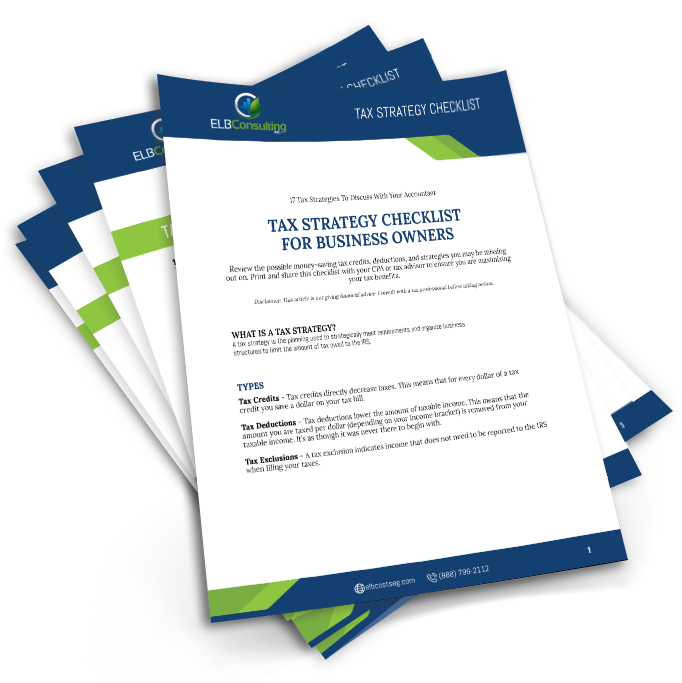What is a Tax Strategy?
A tax strategy is the planning used to strategically meet requirements and organize business structures to limit the amount of tax owed to the IRS.
Types:
Tax Credits – Tax credits directly decrease taxes. This means that for every dollar of a tax credit you save a dollar on your tax bill. Jump to section >
Tax Deductions – Tax deductions lower the amount of taxable income. This means that the amount you are taxed per dollar (depending on your income bracket) is removed from your taxable income. It’s as though it was never there to begin with. Jump to section >
Tax Exclusions – A tax exclusion indicates income that does not need to be reported to the IRS when filing your taxes.
Tax Credits
1. R&D Credits
R&D credits are in place to encourage innovations to business methodology and processes. This credit offsets R&D-related expenses and wages. The changes to the Research Tax Credit effective January 1, 2016 are beneficial for startups, mid-size firms and large companies alike, as well as making it easier for engineering and architectural firms to benefit. They were also made permanent.
Notable Limitations: It must be a new or improved business component that is technological and shows documented experimenting. The success before beginning should also be well-documented as uncertain.
2. Work Opportunity Tax Credit (WOTC)
This credit can provide a total savings of up to $9,000 over the span of two years. It requires a Form 5884.
Notable Limitations: There are 10 categories that are recognized by the IRS as facing significant barriers to employment.
- Unemployed or disabled veterans
- Qualified IV-A TANF recipients
- Residents in Empowerment Zones or Rural Renewal Counties
- Vocational rehabilitation referrals
- Summer youth employees that live in Empowerment Zones
- SSI recipients
- Those receiving long-term family assistance
- Long-term unemployment recipients (must meet qualifications)
- Ex-felons
- Food stamp recipients
3. Disabled Access Credit
This credit is for any business that makes significant efforts to make itself more accessible to those with disabilities.
Notable Limitations: The maximum you’ll receive back is $5,125.
4. New Markets Credit
A business will qualify for this credit if it has made Qualified Equity Investments to community development entities within the tax year of filing. Check out this resource on CDEs and the New Markets Credit to find low-income areas near your business.
Notable Limitations: Review the IRS’s guidelines for the New Markets Credit
5. Family and Medical Leave Credit
This tax credit deducts a percentage of expenses paid by a company to provide paid-leave for an employee. It must be for medical purposes.
Notable Limitations: The employee must be on your payroll for at least one year in order to qualify. Learn more here.
6. Employer-Provided Child Care Credit
This credit provides 25% of up to $150,000 in child care expenses back on taxes to companies that provide child care for employees.
Notable Limitations: Threshold of credit stops at $150,000.
Tax Deductions
7. Section 179 Deductions
This deduction can be used to offset the costs of a certain type of property once moved into service. The main use of the Section 179 Deduction is for machinery and equipment but it can also be applied to qualifying real estate.
Notable Limitations: Up to $1 million in deductions as of 2018.
8. Car Expenses Deduction
Following IRS guidelines, standard mileage rate or actual costs of cars or trucks used for business purposes can be deducted.
Notable Limitations: Cannot write-off commuting or personal use of a vehicle.
Other Strategies
9. Cost Segregation Study
With a cost segregation study building owners will reduce their current tax liability and heighten income. A cost segregation study will examine all components of your buildings as both accelerated and straight-line items. It will depreciate your property faster resulting in positive gains for your business.
You can have a cost segregation study run on your property even if it is not the same year as when you acquired or built the property. Speak to your CPA to find out if they’re taking full advantage of cost segregation studies.
10. Ghost-Asset Study
With a ghost-asset study your fixed asset ledger will be analyzed to identify any ghost-assets. These ghost-assets will then be removed. The result? Reduced taxes and chances of over-insuring.
11. 1031 Exchange
When you sell an appreciated property the capital gain you incur will be taxed by the government if you don’t complete a 1031 Exchange. With a 1031 Exchange, you can send the profits directly into a different property or group of properties. When sent through an intermediary without ever touching the income you will defer the tax. It can be avoided if the property is part of a generational portfolio, but the 1031 per se does not avoid the tax, only defers it.
However, not everyone is eligible for this strategy. You must prove investment intent and the owner of the property where the money is invested and the owner of the property that was sold for the capital gain must be the same.
12. Section 179D
By making your building more energy-efficient you are open to a deduction of up to $1.80 per square foot. This deduction benefits the original owners or builder of the building versus any owner that has recently acquired the property.
13. Fixed Asset Review
The purpose of a fixed asset review is to identify depreciation deductions that have been previously missed and include them in the federal tax filings. Having this review completed can increase the level of cash flow in your business while also preventing any lost depreciation deductions. It can also help to lower chances of an audit.
14. Tax Benefits for Going Green
There is a multitude of tax benefit opportunities surrounding environmentally-friendly efforts depending on the locale of your business. This generally includes changes around use of energy within an office setting.
The benefits could be credits, deductions, or exemptions depending on which you qualify for. Visit DSIRE for a complete list of benefits of going green with your company.
15. Tax Benefits by Employing a Family Member
Certain tax benefits are established when a family business employs another family member. This can include a lowered tax burden and no subjection to FICA taxes for children under 18 employed by a sole proprietor or unincorporated company.
16. Receive Property Payments on an Installment Basis
When selling a property is may be better to arrange to receive payment in installments over two years to prevent paying a higher tax if you were to receive a lump sum.
The reverse can be said if you’ve claimed a major loss. In that case you may want to claim the full gain in the year of the major loss to offset the amount of tax you’ll pay.
17. Change Business Structure Based on Tax Responsibilities
Different business structures come with different benefits but they all have downfalls. Luckily, you aren’t stuck with one structure forever. For example, a sole proprietor has the lowest tax rates. With this, however, you give up on the barrier between yourself and your business which will make you personally liable if someone sues.
What Next?
Reduced Taxes in 3 Steps:
Take these steps to shave money off what you owe:
1. Share This Checklist With A Tax Professional
Tax professionals must stay on top of changes in tax laws and will know the best strategies for your business. Don’t forget to ask your tax professional how they can partner with ELB to reduce your tax liability.
2. Keep Stringent Records
Keeping detailed records throughout the year will make your tax season less stressful. By having all your paperwork and information in order it will also make your accountant’s life easier. This could help them more easily identify ways for you to save.
3. Make Strategic Moves During Year-End Planning
By consulting with a tax professional before the yearly deadlines, you are better able to make strategic plans for your business. As the year closes out take time to review the plans laid out by your financial advisor. Put into action any processes that will save you money when it comes time to file your business taxes.
Over 14,000 Studies Done Since 2002
Your official cost segregation report is based on nearly two decade’s worth of research and experience. We’ve had the pleasure of working with some of America’s top brands.

Ready to get started?

Step One: Call or message us.
Call us at (888) 796-2112, submit the inquiry below for a call back, or request a free quote.
Click to call

Step Two: We perform a fully-engineered study of your property.
We'll do all the heavy lifting to find you the maximum tax deductions you qualify for.

Step Three: We deliver your 'CPA-ready' report.
Get a completed cost segregation study that decreases your tax liability and puts more money in your pocket.

17 Tax Strategies For Business Owners
TAX STRATEGY CHECKLIST
Discover 17 tax strategies to bring to your accountant and ensure you're making the most of your tax benefits. Enter your email address to download your free, printable copy.
